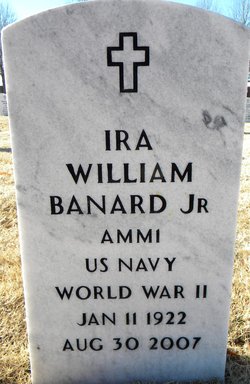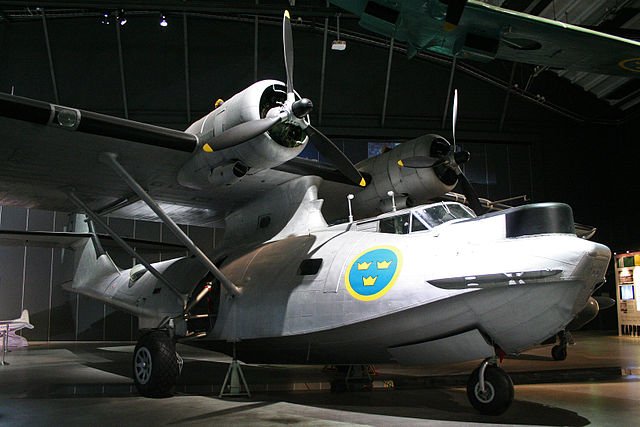Ira William Banard, Jr
1922-2007
Ira William Banard, Jr. was born January 11, 1922 in Fort Smith,Sebastian
Co., Arkansas, to Ira William and Jane Ellen Nona Mae Harris
Banard,Sr. January 10, 1943 in Fort Smith, Ar.
Ira married Dorothy Lee Berkley from Lavaca, Sebastian Co., Ar.
at Midland Heights Methodist Church in Fort Smith, Arkansas.
Ira enlisted in the US Navy September 20, 1942 and served until October 12, 1945.
He was an Aviation Machinist Mate, First Class on the PBY planes. The PBYs were
used in anti-submarine warfare, patrol bombing, convoy escort, search and rescue
missions (especially air-sea rescue), and cargo transport. (and to get Bob Hope
and crew to their destinations in the war zones to entertain the troops.) More
about the PBY's at the bottom of this page.
Ira William Banard, Jr. passed away August 30, 2007 in Macon, Bibb Co., Georgia.
Ira W. Banard, Jr., 87, of Macon, Georgia formerly of Fort Smith, Arkansas
passed away on Thursday, August 30, 2007 in Macon, Georgia. He was born
January 11, 1922 in Fort Smith to Ira W. Banard, Sr. and Ellen Harris Banard.
He was a 1939 graduate of Fort Smith High School, and a member of IEEE
engineering society. He was of the Methodist Faith and was very active in
many church activities including board of directors and a choir soloist,
and was a Navy WWII veteran. He retired from OG&E in 1984 after serving
as Western Division Substation Superintendent.
He was preceded in death by his sister Nettie Mae Silence and grandson Adam Wade
Risener.
Graveside service will be 10:00 a.m. Tuesday, September 4, 2007 at The U.S.
National Cemetery under the direction of Edwards Funeral Home.




The Forgotten Role the PBY Catalina Played in World War II
During World War II, PBYs were used in anti-submarine warfare, patrol bombing,
convoy escort, search and rescue missions (especially air-sea rescue), and cargo
transport.
The type operated in nearly all operational theatres of World War II. The Catalina
served with distinction and played a prominent and invaluable role in the war
against Japan.
These patrol planes shared with land based patrol bombers the combat roles while
the very long range Consolidated LB-30 and the Consolidated Coronado were
pressed into service to increase the all important logistic strategic air lift
capability in the vast Pacific theater. The pairings allowed the Catalina to
take on the role of eyes of the fleets at longer ranges than the float plane
scouts.
Several different flying boats were adopted by the Navy, but the PBY was the most
widely used and produced.
Although slow and ungainly, Allied forces used Catalinas in a wide variety of
roles for which the aircraft was never intended. PBYs are remembered for their
rescue role, in which they saved the lives of hundreds of aircrew downed over
water. Catalina airmen called their aircraft the "Cat" on combat missions and
"Dumbo" in air-sea rescue service.
The Catalina scored the U.S. Navy's first credited air-to-air "kill" of a Japanese
airplane in the Pacific War. On 10 December 1941, the Japanese attacked the
Cavite Navy Yard in the Philippines. Numerous U.S. ships and submarines were
damaged or destroyed by bombs and bomb fragments. While flying to safety during
the raid on Cavite, Lieutenant Harmon T. Utter's PBY was attacked by three
Japanese Mitsubishi A6M2 Type 0 carrier fighters. Chief Boatswain Earl D. Payne,
Utter's bow gunner, shot down one, thus scoring the U.S. Navy's first kill.
Utter, as a commander, later coordinated the carrier air strikes that led to
the destruction of the Japanese battleship Yamato.
The Catalina performed one of the first offensive operations against the Japanese
by the US. On 27 December 1941, six Catalinas of Patrol Squadron 101 bombed
Japanese shipping at Jolo Island against heavy fighter opposition, with four
Catalinas lost.
Anti-submarine warfare
Catalinas were the most extensively used anti-submarine warfare (ASW) aircraft
in both the Atlantic and Pacific theaters of World War II, and were also used
in the Indian Ocean, flying from the Seychelles and from Ceylon. Their duties
included escorting convoys to Murmansk. By 1943, U-boats were well-armed with
anti-aircraft guns and two Victoria Crosses were won by Catalina pilots pressing
home their attacks on U-boats in the face of heavy fire: Flying Officer John
Cruickshank of the RAF, in 1944, for sinking U-347 (although the submarine is
now known to have been U-361) and in the same year Flight Lieutenant David
Hornell of the Royal Canadian Air Force (posthumously) against U-1225. Catalinas
destroyed 40 U-boats, but not without losses of their own. A Brazilian Catalina
attacked and sank U-199 in Brazilian waters on 31 July 1943. Later, the aircraft
was baptized as "Arará", in memory of the merchant ship of that name which was
sunk by another U-boat
More can be found about the amazing PHY's of WWII
HERE
|
|
|
|